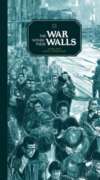
The War within these Walls
Written by Aline Sax
Illustrated by Caryl Strezeleck
Translated by Laura Watkinson
Eerdmans Books for Young Readers, 172 pp.
ISBN: 978-0802854285
This poignant first-person story of a Jewish teen’s experiences begins in 1940 when his family is herded into the Warsaw Ghetto. This brief novel is powerfully illustrated with pen, ink, and pencil drawings that capture the raw emotions of the protagonist, his family, and fellow Jews as well as the Nazi soldiers who are intent upon crushing them. Alternating black and white pages reinforce the forces of darkness and light at work in this story. Added to the tall, thin shape, the design of this book captures the reader’s attention and the story holds the reader in its grip.
Harassment, possessions requisitioned, and armbands lead Misha to say, “I never felt so Jewish before” (p. 13). The Nazis build a ten-foot-high wall of bricks, barbed wire, and shards of glass around the small section of Warsaw where the Jews have been segregated from the Aryan population. For Misha, the war is both within the walls of the Warsaw Ghetto and within the walls of his own mind. The story begins with the Nazi invasion of Poland and the subsequent imprisonment of the Jewish population. It also begins within Misha himself as he struggles with humiliation and despair about the appalling circumstances in which his family must try to survive.
Along with his physician father, mother, and little sister Janina, Misha suffers daily deprivation. He wrestles with feelings of anger and shame as he watches more and more “relocated” Jews arrive. “Like dirty water, they kept pouring into the mouth and nostrils of the ghetto. Until it would be impossible for us to breathe” (p. 22). The Nazis begin starving the Jews. When patients can no longer pay with food for Misha’s father’s services, the family barters for a bit of bread, and Janina sells her doll for an ounce of lard. When there is nothing left to trade, sickness and death are all they know—all they can hope for.
One day, Misha sees a beautiful parakeet on the ghetto wall, the sight of which for a moment silences the horror all around him. “If it was so easy for the bird to fly over the wall, why couldn’t I do it?” (p. 43). Desperation forces Misha to plunge into the dank sewers to get past the wall and out through a manhole to find food in the city for his starving family. This works for a time until his sister follows him and joins him in procuring food by any means possible. One day, Janina does not return. Sensitive especially to his mother’s hunger, Misha is devastated. He asks himself if his mother will have to die because of his own fear. On one black page with a powerful illustration of Misha, we read his thoughts: “I hated myself” (p. 83).
Another member of the ghetto, Mordechai Anielewicz, invites Misha to join the resistance. Misha risks his life daily as he finds a reason to live in the people and plots of the movement. He is empowered; he takes action. He breaks through the walls of hopelessness. He resists. He does not believe the Nazis’ stories about “resettling” Jews to Russian villages; he has heard about trains and Auschwitz. He sees the Nazis continue to murder the Jews cordoned within the ghetto and then the soldiers begin to destroy the ghetto itself.
In the end, Misha participates in the Warsaw Ghetto uprising in which a band of resistance fighters with stolen weapons and homemade bombs pushes back the Nazi soldiers. When the soldiers respond with artillery, the resistance fighters know they are not fighting to win, but rather hope for an honorable death. When the uprising fails as they know it will, everyone remaining in the ghetto, children, women, men, and resistance fighters alike, is slaughtered in their hiding places. And when all seems lost, Misha emerges from a manhole cover on the other side of the wall and takes flight to what optimistic readers pray will be freedom and eventual safety. “I closed my eyes and flew out of the ghetto” (p. 169).
The Historical Note states that Misha is a fictional character, but the events of the story are based on true accounts. Mordechai Anielewicz was the real commander of the Warsaw Ghetto resistance forces; he was only twenty-three at the time. The author helps readers begin to understand the desperation and determination that lead 750 ill-armed Jewish fighters to battle against over two thousand well-armed Nazi soldiers and hold them off for four weeks. Misha’s story and the images in this slim volume will live in readers’ hearts and minds long after they turn the last page.
This book, based on true events, could be paired with informational books written from a young person’s point of view that deal with the experiences of young adults during the Holocaust including Ben’s Story: Holocaust Letters with Selections from the Dutch Underground Press by Benjamin Wessels (2001), Hidden Letters by annotated by Deborah Slier and Ian Shine, translated by Marion van Binsbergen-Pritchard (2008), I Have Lived A Thousand Years by Livia Bitton Jackson (1999), and Surviving Hitler: A Boy in the Nazi Death Camps by Andrea Warren (2002).
The War within these Walls is a 2014 Mildred L. Batchelder Award Honor Book and is also listed on the 2014 USBBY Outstanding International Books List for grade 9 – 12.
Judi Moreillon, School of Library and Information Studies, Texas Woman’s University, Denton, TX
WOW Review, Volume VI, Issue 3 by Worlds of Words is licensed under a Creative Commons Attribution-NonCommercial-ShareAlike 4.0 International License. Based on work at https://wowlit.org/on-line-publications/review/vi-3/
